 Women in the UK on average earn less per hour than men. According to the Annual Survey of Hours and Earnings, the mean hourly pay for women in 2015 was 17.5% less than that for men. This figure is for all employees, full and part time. As far as full-time employees is concerned, the gap was slightly smaller at 13.9%. Nevertheless, as you can see from Table 6 in the linked Excel file, these gaps have decreased in recent years – but only slightly.
Women in the UK on average earn less per hour than men. According to the Annual Survey of Hours and Earnings, the mean hourly pay for women in 2015 was 17.5% less than that for men. This figure is for all employees, full and part time. As far as full-time employees is concerned, the gap was slightly smaller at 13.9%. Nevertheless, as you can see from Table 6 in the linked Excel file, these gaps have decreased in recent years – but only slightly.
A recent paper from the Institute for Fiscal Studies has disaggregated the figures to give a better picture of this wage gap. It finds that having children is a major contributing factor to the gap. It also finds that this has a bigger impact on the earnings of graduates and those without a degree but with A levels.
On entry to the labour market, men and women earn roughly the same. People’s wages tend to rise during their 20s, but men’s rise slightly faster than women’s, causing a pay gap to open and widen – but slowly at first. Average (mean) men’s wages continue to grow during their 30s and a bit during their 40s. However, average women’s wages flatline. Thus the wage gap grows substantially, especially for the higher educated.
The paper argues that the arrival of children is a major contributing factor to this picture. It looks at the gap before and after the arrival of children. “The crucial observation is that the gap opens up gradually after the first child arrives and continues to widen for many years after that point.” By 12 years after the first child is born, the wage gap has widened to 33%.
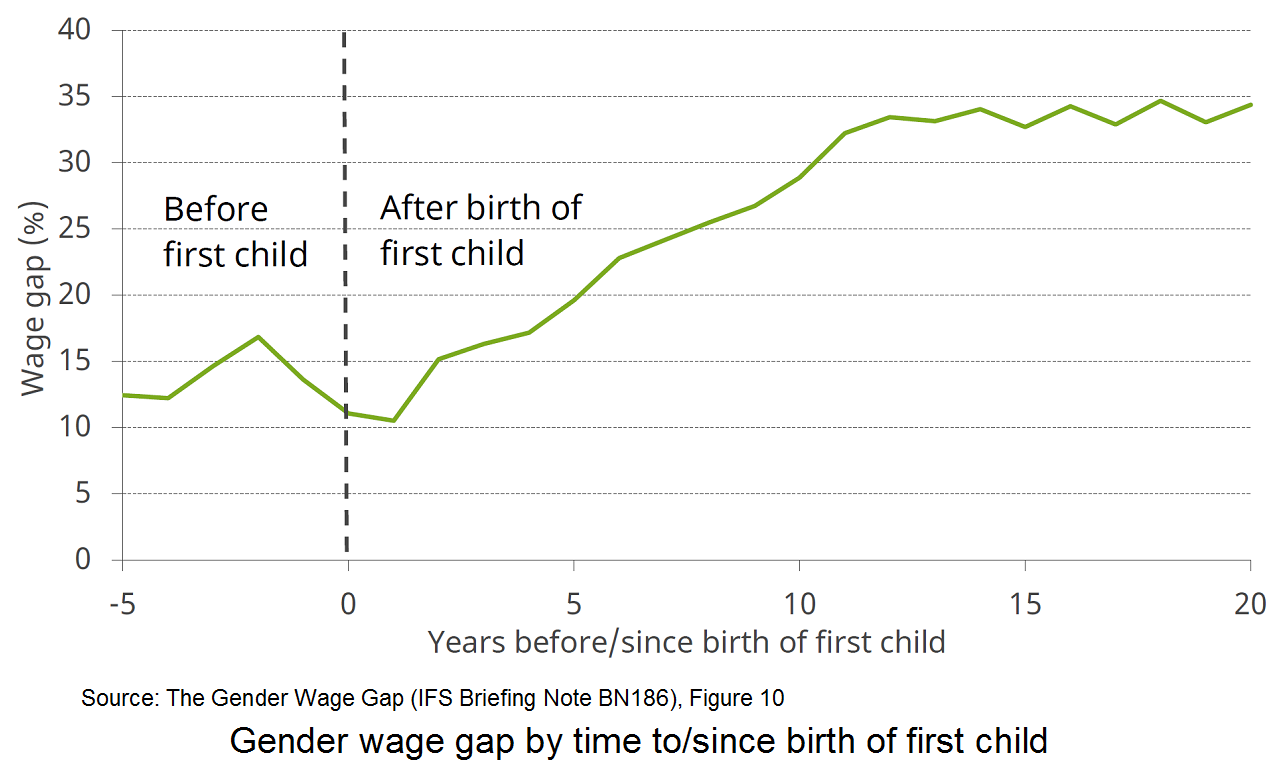
The paper does not offer reasons for the small gap that exists before the arrival of children. But it does give possible reasons for the widening gap after having children. A major one, it suggests, has to do with labour market experience.
“As women are likely to do less paid work after the arrival of children, the level of labour market experience they have falls further and further behind that of their male counterparts, and the wage gap therefore widens.” They may also miss out on promotions.
Each year a woman spends away from the labour market is associated with an average 2% drop in pay compared with those who remain in work. For those with at least A levels, the penalty is 4%; but there is no drop in pay for those without A levels.
Other possible explanations include mothers taking work that requires a lower skill level, and at lower hourly pay, in order to gain flexibility in working hours. However, the evidence suggests that women who move to part-time work on having a child suffer no immediate drop in pay. But their hourly pay does grow more slowly, thus contributing to a widening of the gap.
Another explanation is employers exercising market power to discriminate against women with children. The paper does not consider this explanation.
The articles discussing the paper look at policy implications and identify various things that can be done to narrow the gap. Read the paper and articles and try answering the questions below.
Videos and podcasts
 IFS: gender pay gap widens after first child Compendium of News Reports from BBC News at Six, Channel 4 News, ITV News at Ten and BBC Newsnight from Incorrigible Forever on YouTube (23/8/16)
IFS: gender pay gap widens after first child Compendium of News Reports from BBC News at Six, Channel 4 News, ITV News at Ten and BBC Newsnight from Incorrigible Forever on YouTube (23/8/16)
 Gender Pay Gap Hits Women With Children Hardest Sky News (23/8/16)
Gender Pay Gap Hits Women With Children Hardest Sky News (23/8/16)
 In Business: Supportive partner = success at work World of Business, BBC Radio 4, Peter Day (25/8/15)
In Business: Supportive partner = success at work World of Business, BBC Radio 4, Peter Day (25/8/15)
 Gender Pay Gap More or Less, BBC Radio 4, Tim Harford (26/8/16)
Gender Pay Gap More or Less, BBC Radio 4, Tim Harford (26/8/16)
 Gender pay gap: Why do mums increasingly earn less? BBC Victoria Derbyshire programme (23/8/16)
Gender pay gap: Why do mums increasingly earn less? BBC Victoria Derbyshire programme (23/8/16)
Articles
UK women still far adrift on salary and promotion as gender pay gap remains a gulf The Guardian, Katie Allen (23/8/16)
Gender pay gap: mothers returning to work earn a third less than men The Telegraph, Tim Wallace (23/8/16)
Mothers’ pay lags far behind men BBC News (23/8/16)
Four ways the gender pay gap isn’t all it seems BBC News Magazine, Simon Maybin (29/8/16)
Six ways to tackle the gender pay gap BBC News, Emma Atkinson (23/8/16)
Wage gap for UK women unchanged in 20 years Financial Times, Gemma Tetlow (23/8/16)
The UK’s slow march to gender pay equality Financial Times (23/8/16)
Gender Pay Gap For Mothers Widens For 12 Years After Having Children, New Research Finds Huffington Post, Jack Sommers (23/8/16)
Motherhood costs women a third of their salary compared to men, report reveals Independent, Joe Watts (23/8/16)
The gender pay gap means that more women will be in poverty later in life – but there is something the government can do Independent, Claire Turner (26/8/16)
Gender pay gap won’t close until 2069, says Deloitte The Guardian, Katie Allen (24/9/16)
Papers and Reports
Gender wage gap grows year on year after childbirth as mothers in low-hours jobs see no wage progression IFS Press Release (23/8/16)
The Gender Wage Gap IFS Briefing Note BN18, William Elming , Robert Joyce and Monica Costa Dias (23/8/16)
Women in STEM: Technology, career pathways and the gender pay gap Deloitte (September 2016)
Data
Gender pay differences: Annual Survey of Hours and Earnings: 2015 Provisional Results ONS Statistical Bulletin (18/11/15)
All data related to Annual Survey of Hours and Earnings: 2015 Provisional Results ONS datasets (18/11/15)
ASHE 1997 to 2015 selected estimates (See Tables 1 to 4, 6 and 9) ONS dataset (18/11/15)
All Employees – ASHE: Table 1 ONS dataset (18/11/15)
Questions
- Identify possible reasons for the wage gap between men and women.
- Why is the median wage gap different from the mean wage gap?
- Why is the wage penalty for periods without work greater for more highly educated women?
- To what extent is the gender wage gap a reflection of marginal productivity differences?
- Is the gender pay gap primarily about men and women being paid differently for doing the same job?
- What evidence is provided by the Chartered Management Institute (CMI) on women’s lack of pay progression?
- What could the government do to reduce the wage gap?
- Discuss the relative effectiveness of different policy alternatives.
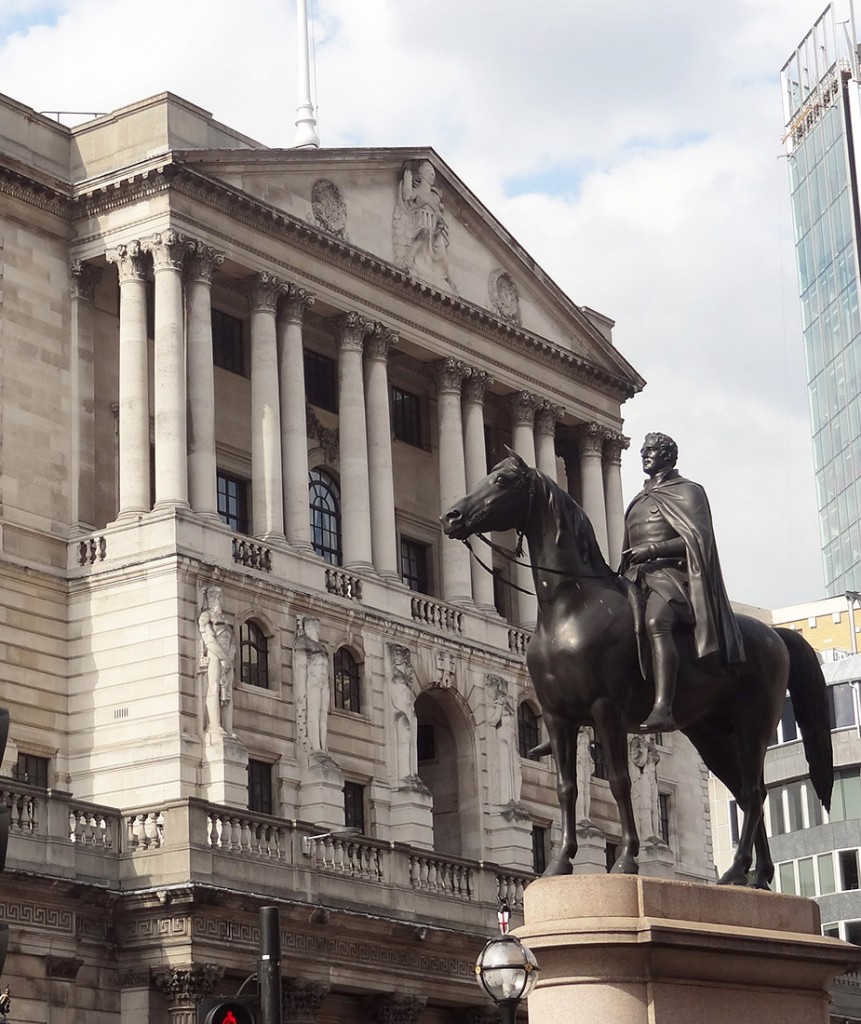 The Bank of England has responded to forecasts of a dramatic slowdown in the UK economy in the wake of the Brexit vote. On 4th August, it announced a substantial easing of monetary policy, but still left room for further easing later.
The Bank of England has responded to forecasts of a dramatic slowdown in the UK economy in the wake of the Brexit vote. On 4th August, it announced a substantial easing of monetary policy, but still left room for further easing later.
Its new measures are based on the forecasts in its latest 3-monthly Inflation Report. Compared with the May forecasts, the Report predicts that, even with the new measures, aggregate demand growth will slow dramatically. As a result, over the next two years cumulative GDP growth will be 2.5% lower than it would have been with a Remain vote and unemployment will rise from 4.9% to around 5.5%.
What is more, the slower growth in aggregate demand will impact on aggregate supply. As the Governor said in his 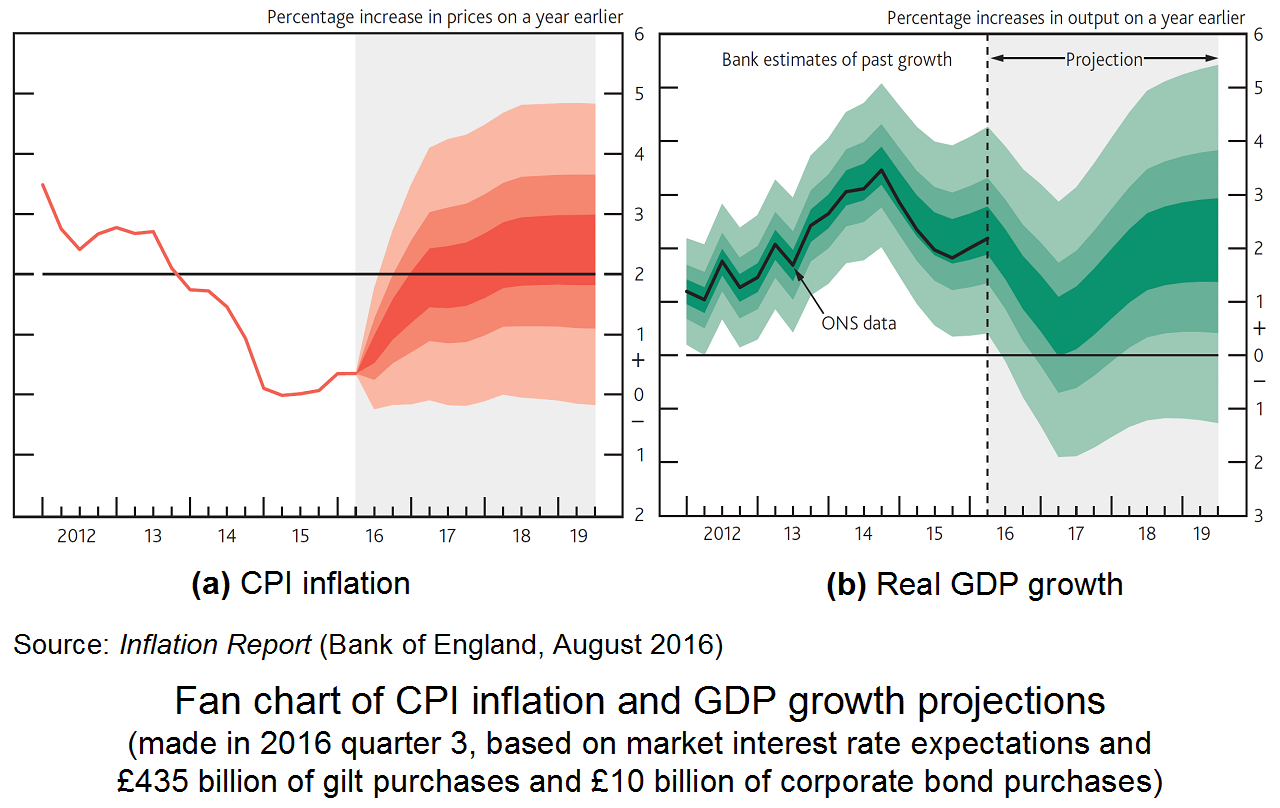 opening remarks at the Inflation Report press conference:
opening remarks at the Inflation Report press conference:
“The weakness in demand will itself weigh on supply as a period of low investment restrains growth in the capital stock and productivity.
There could also be more direct implications for supply from the decision to leave the European Union. The UK’s trading relationships are likely to change, but precisely how will be unclear for some time. If companies are uncertain about the future impact of this on their businesses, they could delay decisions about building supply capacity or entering new markets.”
Three main measures were announced.
|
|
| • |
A cut in Bank Rate from 0.5% to 0.25%. This is the first time Bank Rate has been changed since March 2009. The Bank hopes that banks will pass this on to customers in terms of lower borrowing rates. |
| • |
A new ‘Term Funding Scheme (TFS)’. “Compared to the old Funding for Lending Scheme, the TFS is a pure monetary policy instrument that is likely to be more stimulative pound-for-pound.” The scheme makes £100bn of central bank reserves available as loans to banks and building societies. These will be at ultra-low interest rates to enable banks to pass on the new lower Bank Rate to customers in all forms of lending. What is more, banks will be charged a penalty if they do not lend this money. |
| • |
An expansion of the quantitative easing programme beyond the previous £375 billion of gilt (government bond) purchases. This will consist of an extra £60bn of gilt purchases and the purchase of up to £10bn of UK corporate bonds. |
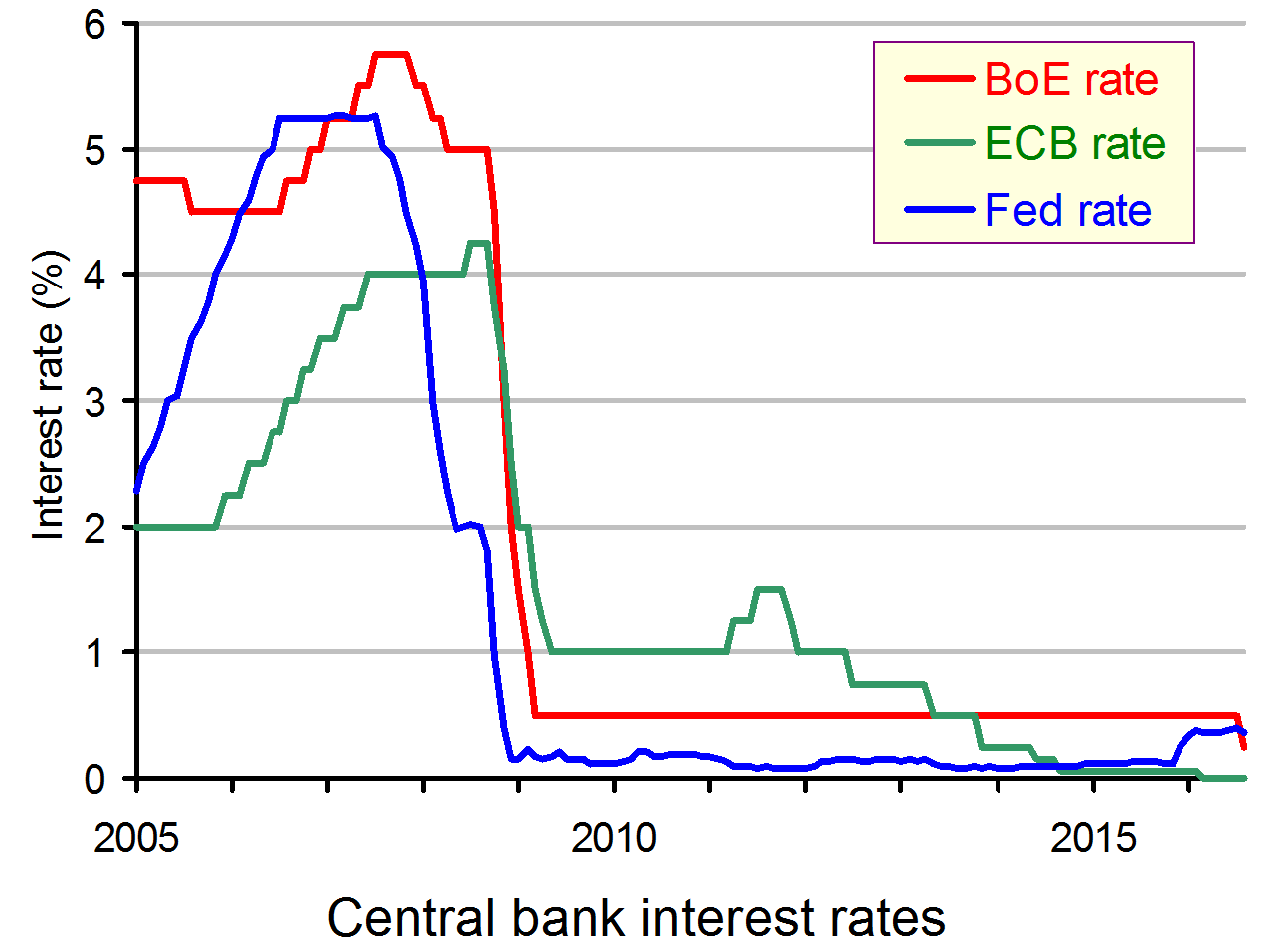 The Bank recognises that there is a limit to what monetary policy can do and that there is also a role to play for fiscal policy. The new Chancellor, Philip Hammond, is considering what fiscal measures can be taken, including spending on infrastructure projects. These are likely to have relative high multiplier effects and would also increase aggregate supply at the same time. But we will have to wait for the Autumn Statement to see what measures will be taken.
The Bank recognises that there is a limit to what monetary policy can do and that there is also a role to play for fiscal policy. The new Chancellor, Philip Hammond, is considering what fiscal measures can be taken, including spending on infrastructure projects. These are likely to have relative high multiplier effects and would also increase aggregate supply at the same time. But we will have to wait for the Autumn Statement to see what measures will be taken.
But despite the limits to monetary policy, there is more the Bank of England could do. It already recognises that there may have to be a further cut in Bank Rate, perhaps to 0.1% or even to 0% (the ECB has a 0% rate). There could also be additional quantitative easing or additional term funding to banks.
 Some economists argue that the Bank should go further still and, in conjunction with the Treasury, provide new money directly to fund infrastructure spending or tax cuts, or even as cash handouts to households. This extra money provided to the government would not increase government borrowing.
Some economists argue that the Bank should go further still and, in conjunction with the Treasury, provide new money directly to fund infrastructure spending or tax cuts, or even as cash handouts to households. This extra money provided to the government would not increase government borrowing.
We discussed the use of this version of ‘helicopter money’ in the blogs, A flawed model of monetary policy, Global warning and People’s quantitative easing. Some of the articles below also consider the potential for this type of monetary policy. In a letter to The Guardian 35 economists advocate:
A fiscal stimulus financed by central bank money creation [which] could be used to fund essential investment in infrastructure projects – boosting the incomes of businesses and households, and increasing the public sector’s productive assets in the process. Alternatively, the money could be used to fund either a tax cut or direct cash transfers to households, resulting in an immediate increase of household disposable incomes.
Webcasts and podcasts
 Inflation Report Press Conference Bank of England, Mark Carney (4/8/16)
Inflation Report Press Conference Bank of England, Mark Carney (4/8/16)
 Bank spells out chance of further rate cut this year BBC Radio 4 Today Programme, Ben Broadbent, Deputy Governor of the Bank of England (5/8/16)
Bank spells out chance of further rate cut this year BBC Radio 4 Today Programme, Ben Broadbent, Deputy Governor of the Bank of England (5/8/16)
 Broadbent Ready to Back Another BOE Rate Cut Amid Slowdown Bloomberg, Chris Wyllie (5/8/16)
Broadbent Ready to Back Another BOE Rate Cut Amid Slowdown Bloomberg, Chris Wyllie (5/8/16)
 What’s Top of Mind? ‘Helicopter Money’ Goldman Sachs Macroeconomic Insights, Allison Nathan (April 2016)
What’s Top of Mind? ‘Helicopter Money’ Goldman Sachs Macroeconomic Insights, Allison Nathan (April 2016)
Articles
Bank of England measures
Interest rate cut: What did the Bank of England announce today and how will it affect you? Independent, Ben Chu (5/8/16)
This is the Bank of England’s all-action response to Brexit The Guardian, Larry Elliott (4/8/16)
Bank of England unveils four-pronged stimulus package in bid to avoid Brexit recession The Telegraph, Szu Ping Chan (4/8/16)
Record-breaking Bank of England Financial Times, Robin Wigglesworth (4/8/16)
The Bank of England has delivered – now for a fiscal response Financial Times (4/8/16)
Bank of England Cuts Interest Rate to Historic Low, Citing Economic Pressures New York Times, Chad Bray (4/8/16)
Sledgehammer? This is more like the small tool to fix a fence The Telegraph, Andrew Sentance (5/8/16)
All eyes are on Hammond as Bank runs low on options The Telegraph, Tom Stevenson (6/8/16)
Bank of England’s stimulus package has bought the chancellor some time The Guardian, Larry Elliott (7/8/16)
Helicopter money
A post-Brexit economic policy reset for the UK is essential Guardian letters, 35 economists (3/8/16)
Cash handouts are best way to boost British growth, say economists The Guardian, Larry Elliott (4/8/16)
Helicopter money: if not now, when? Financial Times, Martin Sandbu (2/8/16)
The helicopters fly on for now, but one day they will crash The Telegraph, Tom Stevenson (23/7/16)
Is the concept of ‘helicopter money’ set for a resurgence? The Conversation, Phil Lewis (2/8/16)
Helicopter money talk takes flight as Bank of Japan runs out of runway Reuters, Stanley White (30/7/16)
Helicopters 101: your guide to monetary financing Deutsche Bank Research, George Saravelos, Daniel Brehon and Robin Winkler (15/4/16)
Helicopter money is back in the air The Guardian, Robert Skidelsky (22/9/16)
Bank of England publications
Inflation Report, August 2016 Bank of England (4/8/16)
Inflation Report Press Conference: Opening Remarks by the Governor Bank of England, Mark Carney (4/8/16)
Inflation Report Q&A Bank of England Press Conference (4/8/16)
Inflation Report, August 2016: Landing page Bank of England (4/8/16)
Questions
- Find out the details of the previous Funding for Lending (FLS) scheme. How does the new Term Funding Scheme (TFS) differ from it? Why does the Bank of England feel that TFS is likely to be more effective than FLS in expanding lending?
- What is the transmission mechanism between asset purchases and real aggregate demand?
- What factors determine the level of borrowing in the economy? How is cutting Bank Rate from 0.5% to 0.25% likely to affect borrowing?
- If the Bank of England’s latest forecast is for a significant reduction in economic growth from its previous forecast, why did the Bank not introduce stronger measures, such as larger asset purchases or a cut in Bank Rate to 0.1%?
- What are the advantages and disadvantages of helicopter money in the current circumstances? If helicopter money were used, would it be better to use it for funding public-sector infrastructure projects or for cash handouts to households, either directly or in the form of tax cuts?
- How does the Bank of England’s measures of 4 August compare with those announced by the Japanese central bank on 29 July?
- What effects can changes in aggregate demand have on aggregate supply?
- What supply-side policies could the government adopt to back up monetary and fiscal policy? Are the there lessons here from the Japanese government’s ‘three arrows’?
 In a recent blog, Falling sterling – bad for some; good for others, we looked at the depreciation of sterling following the Brexit vote. We saw how it will have beneficial effects for some, such as exporters, and adverse effects for others, such as consumers having to pay a higher price for imports and foreign holidays. The article linked below examines these effects in more depth.
In a recent blog, Falling sterling – bad for some; good for others, we looked at the depreciation of sterling following the Brexit vote. We saw how it will have beneficial effects for some, such as exporters, and adverse effects for others, such as consumers having to pay a higher price for imports and foreign holidays. The article linked below examines these effects in more depth.
Just how much the quantity of exports will increase depends on two main things. The first is the amount by which the foreign currency price falls. This depends on what exporters choose to do. Say the pound falls from €1.30 to €1.18. Do exporters who had previously sold a product selling in the UK for £100 and in the eurozone for €130, now reduce the euro price to €118? Or do they put it down by less – say, to €125, thereby earning £105.93 (£(125/1.18)). Their sales would increase by less, but their profit margin would rise.
The second is the foreign currency price elasticity of demand for exports in the foreign markets. The more elastic it is, the more exports will rise for any given euro price reduction.
 It is similar with imports. How much the sales of these fall depends again on two main things. The first is the amount by which the importing companies are prepared to raise sterling prices. Again assume that the pound falls from €1.30 to €1.18 – in other words, the euro rises from 76.92p (£1/1.3) to 84.75p (£1/1.18). What happens to the price of an import to the UK from the eurozone whose euro price is €100? Does the importer raise the price from £76.92 to £84.75, or by less than that, being prepared to accept a smaller profit margin?
It is similar with imports. How much the sales of these fall depends again on two main things. The first is the amount by which the importing companies are prepared to raise sterling prices. Again assume that the pound falls from €1.30 to €1.18 – in other words, the euro rises from 76.92p (£1/1.3) to 84.75p (£1/1.18). What happens to the price of an import to the UK from the eurozone whose euro price is €100? Does the importer raise the price from £76.92 to £84.75, or by less than that, being prepared to accept a smaller profit margin?
The second is the sterling price elasticity of demand for imports in the UK. The more elastic it is, the more imports will fall and, probably, the more the importer will be prepared to limit the sterling price increase.
The article also looks at the effect on aggregate demand. As we saw in the previous blog, a depreciation boosts aggregate demand by increasing exports and curbing imports. The effects of this rise in aggregate demand depends on the degree of slack in the economy and the extent, therefore, that (a) exporters and those producing import substitutes can respond in terms of high production and employment and (b) other sectors can produce more as multiplier effects play out.
Finally, the article looks at the effect of the depreciation of sterling on asset prices. UK assets will be worth less in foreign currency terms; foreign assets will be worth more in sterling. Just how much the prices of internationally traded assets, such as shares and some property, will change depends, again, on their price elasticities of demand. In terms of assets, there has been a gain to UK balance sheets from the depreciation. As Roger Bootle says:
Whereas the overwhelming majority of the UK’s liabilities to foreigners are denominated in sterling, the overwhelming bulk of our assets abroad are denominated in foreign currency. So the lower pound has raised the sterling value of our overseas assets while leaving the sterling value of our liabilities more or less unchanged.
Article
How a lower pound will help us to escape cloud cuckoo land, The Telegraph, Roger Bootle (31/7/16)
Questions
- What determines the amount that exporters from the UK adjust the foreign currency price of their exports following a depreciation of sterling?
- What determines the amount by which importers to the UK adjust the sterling price of their products following a depreciation of sterling?
- What determines the amount by which sterling will depreciate over the coming months?
- Distinguish between stabilising and destabilising speculation? How does this apply to exchange rates and what determines the likelihood of there being destabilising speculation against sterling exchange rates?
- How is UK inflation likely to be affected by a depreciation of sterling?
- Why does Roger Bootle believe that the UK has been living in ‘cloud cuckoo land’ with respect to exchange rates?
- Why has the UK managed to sustain a large current account deficit over so many years?
 In our blog What can we read into signs of easing consumer confidence? we noted the slight easing in consumer confidence that had occurred since the autumn of last year. Nonetheless, at that time, survey data from the European Commission was continuing to show consumer confidence levels still well above their long-run average. However, following the UK vote to leave the European Union consumer confidence has fallen sharply and now the headline confidence indicator has fallen below its long-term average for the first time since June 2013.
In our blog What can we read into signs of easing consumer confidence? we noted the slight easing in consumer confidence that had occurred since the autumn of last year. Nonetheless, at that time, survey data from the European Commission was continuing to show consumer confidence levels still well above their long-run average. However, following the UK vote to leave the European Union consumer confidence has fallen sharply and now the headline confidence indicator has fallen below its long-term average for the first time since June 2013.
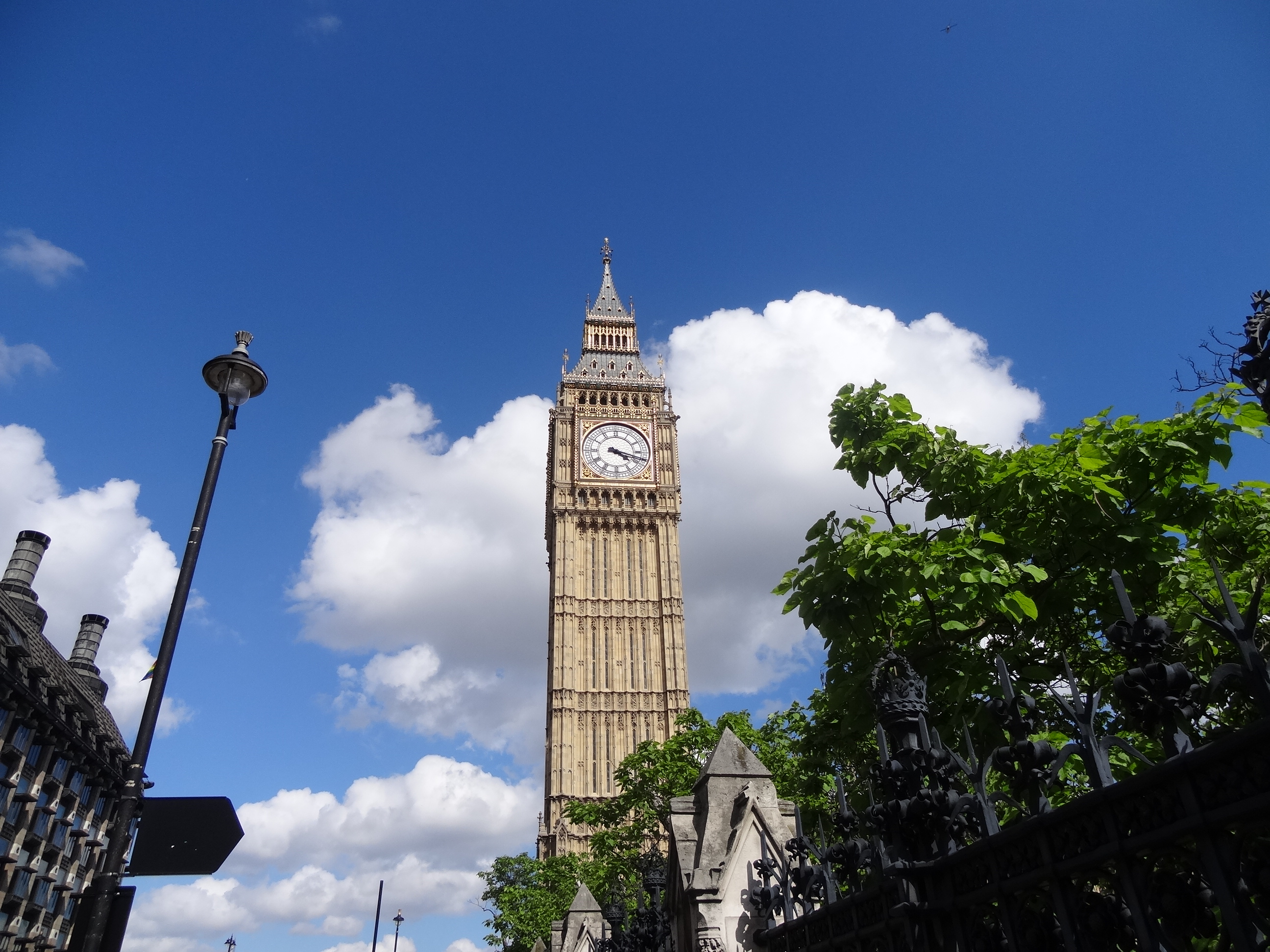 We take this opportunity to update our May blog to better understand the extent and nature of the decline in confidence. The importance of confidence changes is typically modelled by economists in their models of the macroeconomy as a demand-side shock. Falling consumer confidence would be expected to dampen an economy’s output levels since aggregate demand falls as households spend less. Consequently, a marked fall in confidence amounts to a negative demand-side shock.
We take this opportunity to update our May blog to better understand the extent and nature of the decline in confidence. The importance of confidence changes is typically modelled by economists in their models of the macroeconomy as a demand-side shock. Falling consumer confidence would be expected to dampen an economy’s output levels since aggregate demand falls as households spend less. Consequently, a marked fall in confidence amounts to a negative demand-side shock.
The European Commission’s confidence measure is collated from questions in a monthly survey. In the UK around 2000 individuals are surveyed. Across the current 28 member states over 41 000 people are surveyed.
In the survey individuals are asked a series of 12 questions which are designed to provide information on spending and saving intentions. These questions include perceptions of financial well-being, the general economic situation, consumer prices, unemployment, saving and the undertaking of major purchases.
 The responses elicit either negative or positive responses. For example, respondents may feel that over the next 12 months the financial situation of their household will improve a little or a lot, stay the same or deteriorate a little or a lot. A weighted balance of positive over negative replies can be calculated. The balance can vary from –100, when all respondents choose the most negative option, to +100, when all respondents choose the most positive option.
The responses elicit either negative or positive responses. For example, respondents may feel that over the next 12 months the financial situation of their household will improve a little or a lot, stay the same or deteriorate a little or a lot. A weighted balance of positive over negative replies can be calculated. The balance can vary from –100, when all respondents choose the most negative option, to +100, when all respondents choose the most positive option.
The European Commission’s principal consumer confidence indicator is the average of the balances of four of the twelve questions posed: the financial situation of households, the general economic situation, unemployment expectations (with inverted sign) and savings, all over the next 12 months. These forward-looking balances are seasonally adjusted.
Sometimes other combinations of the 12 questions are averaged to produce alternative headline confidence numbers (see, for example, the newspaper articles below). These may include a mix of forward and backward-looking questions. However, in this blog we report on the European Commission’s principal confidence indicator as outlined above. The intention is that this or any other confidence indicator tracks developments in households’ spending intentions and, in turn, likely changes in the rate of growth of household consumption.
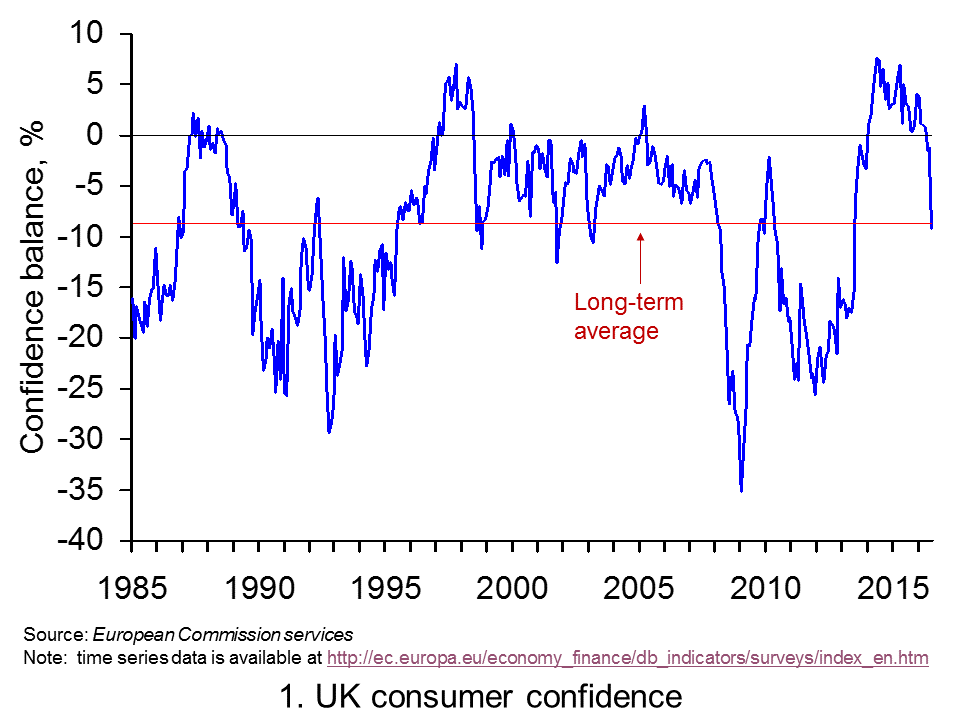 Chart 1 shows the consumer confidence indicator for the UK. The long-term average of –8.7 shows that negative responses across the four questions typically outweigh positive responses.
Chart 1 shows the consumer confidence indicator for the UK. The long-term average of –8.7 shows that negative responses across the four questions typically outweigh positive responses.
In July the confidence balance stood at –9.2 down from –1.2 in June. This 8 point fall is the largest monthly fall in this particular headline indicator since January 1991 when it fell 11 points. The fall also means that not only do negative responses now dominate but more so than is usual. The fall in confidence is therefore very stark indeed. (Click here to download a PowerPoint of the chart.)
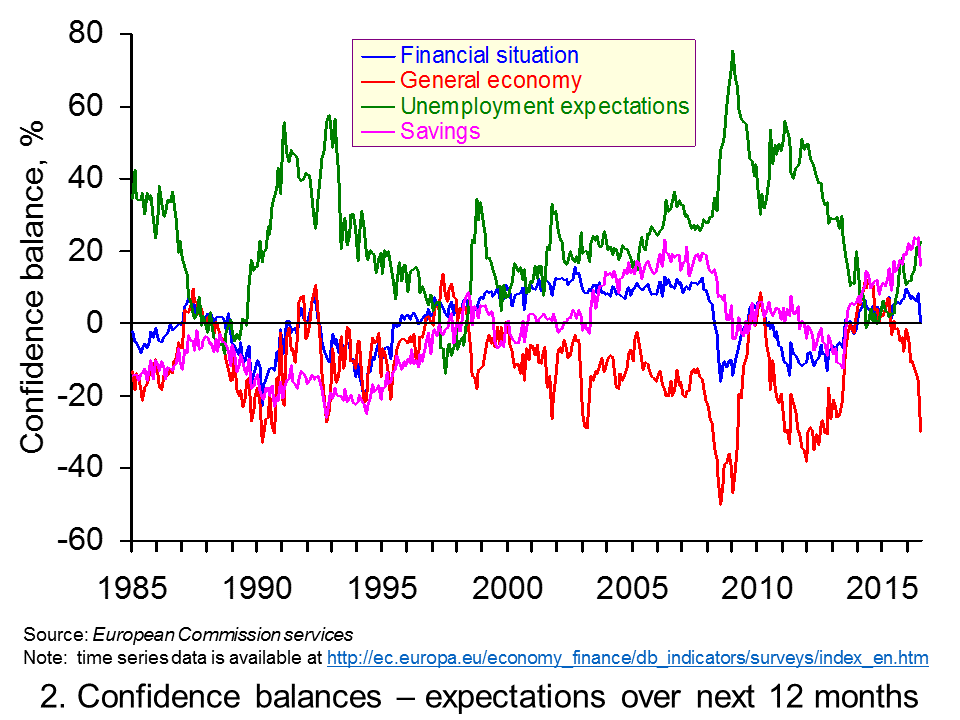 Chart 2 is important because it enables us to see what drives the European Commission’s headline confidence indicator for the UK by looking at its four component balances. The sharp decline in confidence is reflected in a deterioration in all four components. (Click here to download a PowerPoint of the chart.)
Chart 2 is important because it enables us to see what drives the European Commission’s headline confidence indicator for the UK by looking at its four component balances. The sharp decline in confidence is reflected in a deterioration in all four components. (Click here to download a PowerPoint of the chart.)
The most notable change in the individual confidence balances is the sharp deterioration in expectations for the general economy. In July the forward-looking general economic situation balance fell to –29.9 having stood at –15.7 in June. As recently as last December it registered –1.4. This is the lowest forward-looking general economy confidence balance since October 2012, though still some way above the –50.1 reported in July 2008 when the financial crisis was unfolding.
Alongside the 14 point drop in the balance for general economy expectations, the UK experienced 8 point drops in both the balances for households’ financial expectations and the expectations of saving over the next 12 months. In other words, households expect to become financially poorer and less able to save.
The monthly survey contains other questions that can help to predict future spending patterns. For example, we might expect the responses to questions relating to perceptions around what the survey call ‘major purchases’ to give us some important insight in households’ financial well-being and spending plans. ‘Major purchases’ are taken to be items such as furniture, electrical goods and electronic devices.
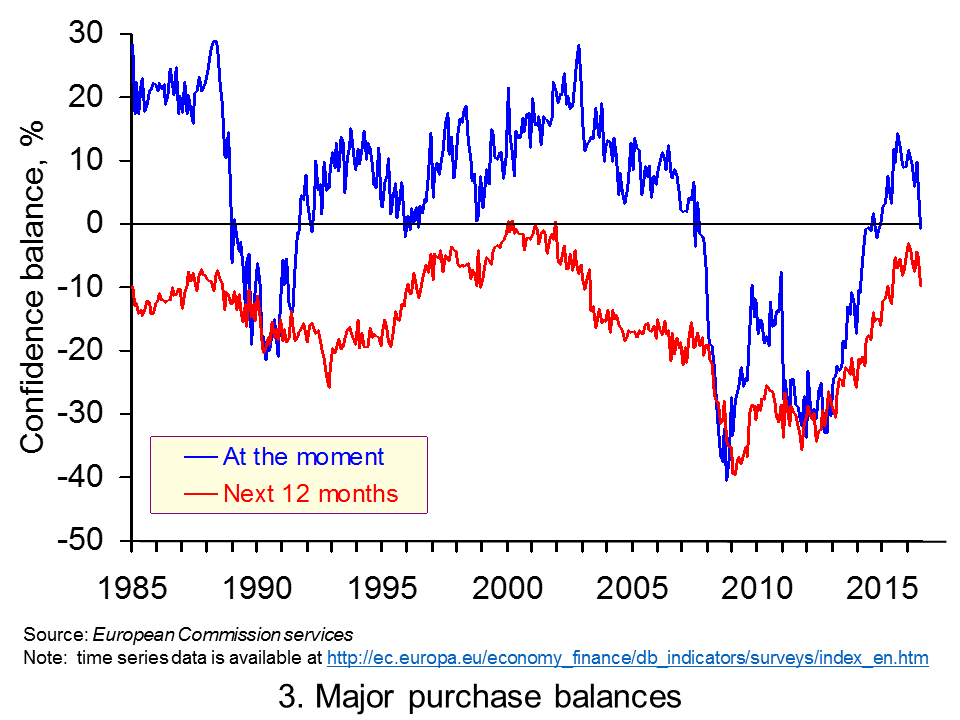 Chart 3 shows the balances to both whether now is the right time to make major purchases and to whether respondents expect to spend more on major purchases in the coming 12 months compared to the past 12 months. July’s data show a marked deterioration in sentiment towards making major purchases. The balance relating to whether now is the right time to make major purchases fell by 6.5 points, the largest fall since December 2011, while the forward-looking major purchase balance fell by 4.6 points, the largest fall since January 2011. (Click here to download a PowerPoint of the chart.)
Chart 3 shows the balances to both whether now is the right time to make major purchases and to whether respondents expect to spend more on major purchases in the coming 12 months compared to the past 12 months. July’s data show a marked deterioration in sentiment towards making major purchases. The balance relating to whether now is the right time to make major purchases fell by 6.5 points, the largest fall since December 2011, while the forward-looking major purchase balance fell by 4.6 points, the largest fall since January 2011. (Click here to download a PowerPoint of the chart.)
The fall in the major purchases balances is consistent with the idea that households are feeling a sense of heightened uncertainty. The implication of this is that households will tend to be more cautious, cutting back on expenditures, including major purchases.
The magnitude of the fall in UK consumer confidence following the outcome of the EU referendum on 23 June is even more stark when compared to developments in consumer confidence across the 28 member states of the European Union and in the 19 countries that make up the Euro area.
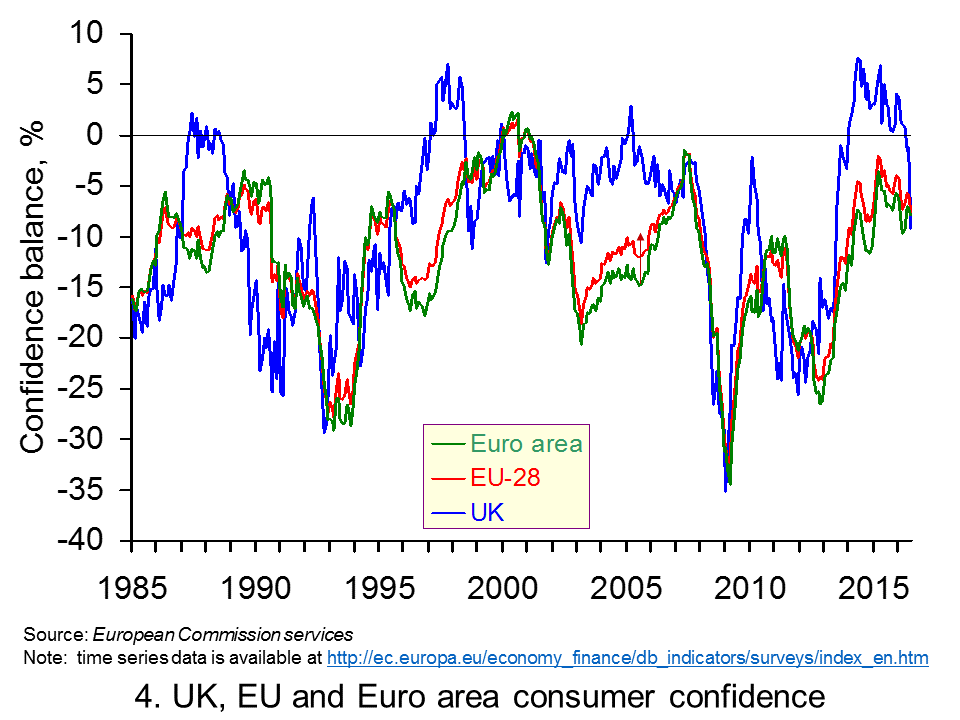 Chart 4 shows how UK consumer confidence recovered relatively more strongly following the financial crisis of the late 2000s. The headline confidence indicator rose strongly from the middle of 2013 and, as we noted earlier, was consistently in positive territory during 2014 and remained so at the start of this year. The slump in consumer confidence in the UK means that the headline confidence measure has now fallen below that across the EU as well as that in the euro area. In fact, confidence in the euro area has been consistently between –7 or –9 for the past six months. (Click here to download a PowerPoint of the chart.)
Chart 4 shows how UK consumer confidence recovered relatively more strongly following the financial crisis of the late 2000s. The headline confidence indicator rose strongly from the middle of 2013 and, as we noted earlier, was consistently in positive territory during 2014 and remained so at the start of this year. The slump in consumer confidence in the UK means that the headline confidence measure has now fallen below that across the EU as well as that in the euro area. In fact, confidence in the euro area has been consistently between –7 or –9 for the past six months. (Click here to download a PowerPoint of the chart.)
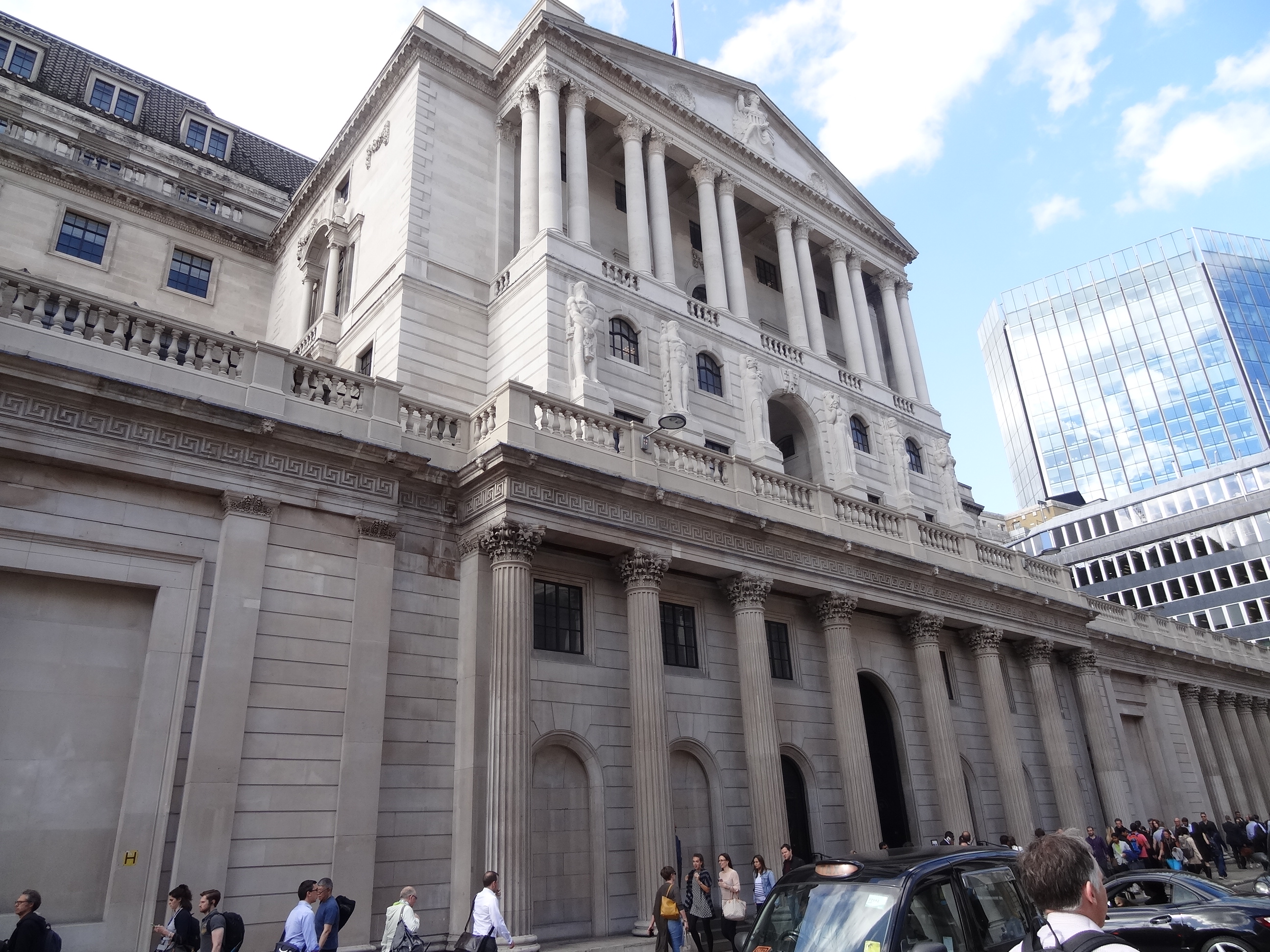 Interest now turns to whether the slump in confidence in the UK will persist or, worse still, deepen further. The implied negative impact on aggregate demand would be expected to translate into weaker growth. The concern therefore is the extent to which we can expect UK growth to weaken in the months ahead. The prospect of weaker growth is likely to influence economic policy.
Interest now turns to whether the slump in confidence in the UK will persist or, worse still, deepen further. The implied negative impact on aggregate demand would be expected to translate into weaker growth. The concern therefore is the extent to which we can expect UK growth to weaken in the months ahead. The prospect of weaker growth is likely to influence economic policy.
The government has already talked about ‘resetting fiscal policy’ which can be taken to mean a relative loosening in its fiscal policy relative to the Government’s original plans. Similarly we might yet see a further loosening of monetary policy. While the Bank of England’s Monetary Policy Committee held the official Bank Rate at 0.5 per cent at its July meeting, many commentators expect a cut sooner rather than later. The confidence data will be one important consideration in the Bank’s calculations.
Articles
UK sees biggest fall in consumer confidence for 26 years after Brexit vote The Guardian, Katie Allen (29/7/16)
UK consumer confidence takes biggest drop since 1990s ITV News (29/7/16)
Consumer confidence suffers biggest drop in 26 years after Brexit vote The Telegraph, Szu Ping Chan (29/7/16)
Consumer confidence slides at fastest pace in 26 years after Brexit vote Indepedent, Ben Chu (29/7/16)
Housing Outlook ’Uncertain’ as Brexit Hits Consumer Confidence Bloomberg, Charlotte Ryan (28/7/16)
Brexit Sees U.K. Consumer Confidence Fall Most Since 1990 Bloomberg, Charlotte Ryan (29/7/16)
Consumer confidence nosedives in Scotland in wake of Brexit vote Herald Scotland, Helen McArdle (29/7/16)
Data
Business and Consumer Surveys European Commission
Questions
- Draw up a series of factors that you think might affect consumer confidence.
- Analyse the ways in which consumer confidence might affect economic activity.
- Explain what you understand by a positive and a negative demand-side shock. How might changes in consumer confidence initiate demand shocks?
- Which of the following statements is likely to be more accurate? (a) Consumer confidence drives economic activity. (b) Economic activity drives consumer confidence.
- What macroeconomic indicators would those compiling the consumer confidence indicator hope that the indicator would help to predict?
- Analyse the possible economic implications of the fall in consumer confidence following the EU referendum vote.
- What economic effects might any persistence in the fall in consumer confidence have?
 This time last year bookmakers Ladbrokes and Coral announced their intention to merge. This was closely followed by a merger between Betfair and Paddy Power. This wave of consolidation appears to have been partly motivated by the rise of online gambling, stricter regulation and increased taxation.
This time last year bookmakers Ladbrokes and Coral announced their intention to merge. This was closely followed by a merger between Betfair and Paddy Power. This wave of consolidation appears to have been partly motivated by the rise of online gambling, stricter regulation and increased taxation.
The UK Competition and Markets Authority (CMA) commenced an initial investigation into the Ladbrokes-Coral merger in late 2015 and, at the request of the merging parties, agreed to fast track the case to a detailed phase 2 investigation.
Despite the growth in the online market, the CMA’s investigation recognised the continued importance of high-street betting shops:
Although online betting has grown substantially in recent years, the evidence we’ve seen confirms that a significant proportion of customers still choose to bet in shops – and many will continue to do so after the merger.
The CMA identified almost 650 local markets where it believed there would be a substantial lessening of competition. It concluded that this could have both local and national effects:
Discounts and offers of free bets to individual customers are 2 of the ways betting shops respond to local competition which could be threatened by the merger. Such a widespread reduction in competition at the local level could also worsen those elements that are set centrally, such as odds and betting limits.
Therefore, earlier this week the CMA announced that before it is prepared to clear the merger, the parties must sell around 350 stores in order to preserve competition in the problem markets (many of these overlap so the number of store sales required is less than the number of problem markets). This divestment represents around 10% of the total number of stores currently owned by the two merging parties. It appears that rivals Betfred and Boylesports, plus a number of private equity investors, are already interested in purchasing the stores.
This may also not be the last consolidation in the industry with the struggling leading bookmaker William Hill apparently attracting merger interest from rival 888 in combination with a casino and bingo hall operator.
Articles
BHA warns CMA over Coral-Ladbrokes merger Racing Post, Bill Barber (7/7/16)
Ladbrokes-Gala Coral must sell 350-400 shops to clear merger BBC, (26/7/16)
William Hill is lukewarm on ambitious three-way merger deal The Telegraph, Ben Martin (25/7/16)
Questions
- Why might the merging parties in this case have been so keen to fast track the case to phase 2?
- What are the key factors in defining the market in this case? How do you think these would have affected the decision?
- Are there arguments that wider social issues in addition to the effect on competition should be taken into account when considering mergers in this market?
- Which of the potential purchasers of the divested stores do you think might be best for competition?
- How do you think this market will evolve in the future?
 Women in the UK on average earn less per hour than men. According to the Annual Survey of Hours and Earnings, the mean hourly pay for women in 2015 was 17.5% less than that for men. This figure is for all employees, full and part time. As far as full-time employees is concerned, the gap was slightly smaller at 13.9%. Nevertheless, as you can see from Table 6 in the linked Excel file, these gaps have decreased in recent years – but only slightly.
Women in the UK on average earn less per hour than men. According to the Annual Survey of Hours and Earnings, the mean hourly pay for women in 2015 was 17.5% less than that for men. This figure is for all employees, full and part time. As far as full-time employees is concerned, the gap was slightly smaller at 13.9%. Nevertheless, as you can see from Table 6 in the linked Excel file, these gaps have decreased in recent years – but only slightly.
 IFS: gender pay gap widens after first child Compendium of News Reports from BBC News at Six, Channel 4 News, ITV News at Ten and BBC Newsnight from Incorrigible Forever on YouTube (23/8/16)
IFS: gender pay gap widens after first child Compendium of News Reports from BBC News at Six, Channel 4 News, ITV News at Ten and BBC Newsnight from Incorrigible Forever on YouTube (23/8/16) Gender Pay Gap Hits Women With Children Hardest Sky News (23/8/16)
Gender Pay Gap Hits Women With Children Hardest Sky News (23/8/16) In Business: Supportive partner = success at work World of Business, BBC Radio 4, Peter Day (25/8/15)
In Business: Supportive partner = success at work World of Business, BBC Radio 4, Peter Day (25/8/15) Gender Pay Gap More or Less, BBC Radio 4, Tim Harford (26/8/16)
Gender Pay Gap More or Less, BBC Radio 4, Tim Harford (26/8/16) Gender pay gap: Why do mums increasingly earn less? BBC Victoria Derbyshire programme (23/8/16)
Gender pay gap: Why do mums increasingly earn less? BBC Victoria Derbyshire programme (23/8/16)

















